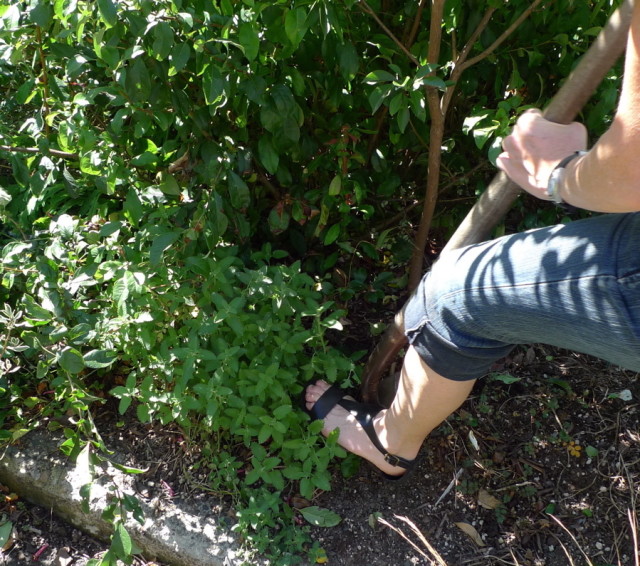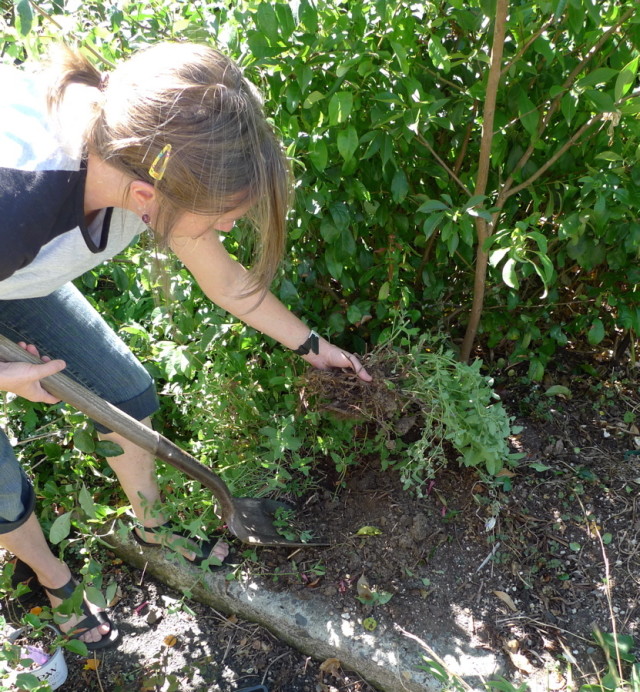Plant Division Leads to Multiplication!

I don’t recommend wearing fancy sandals while dividing perennials!
It may sound weird but division results in multiplication – in the garden, anyway. Divide your perennials and you’ll multiply their offspring exponentially – by a factor of two, at least, every time!
And September is the time to start thinking about division, as the season shifts from high summer to late summer (no matter how rainy or cold it gets, the calendar says it’s still summer so I’m sticking to it!).
Clumping, herbaceous perennial plants – particularly spring and early summer flowering perennials like peony, hosta, and iris – are best divided as the weather shifts from summer to fall (Septemberish). While many fall-blooming perennials can be divided this month, it’s undeniably harder to plunge a shovel into the midst of a plant covered in flowers than one that’s fading into autumn rest. So, to avoid feeling like a horrid, horticultural kill-joy, make it a spring project to divide your fall-bloomers. And a fall project to divide your spring bloomers. And then just don’t be too afraid to break the rules from time to time.

Catmint (Nepeta x fassenii ’Walker’s Low) is easy to divide – every little piece with roots that breaks off can grow.
So why divide? There’s a point at which a big, lusty clump becomes too big and lusty – visually overwhelming, in fact. And when over-crowded, the inside of the clump can die out, starved for nutrients and water. The tell-tale signs are when the plant’s center dies out or flowering becomes sparse. Or the plant starts to annoy you by smothering its neighbor-plants.
What’s so great about dividing in the fall? Well, the soil is still warm, the autumn rains are on the horizon (making your watering chores easier) and the cooler air temperatures and diminishing light (ie, seasonal shift) helps plants focus on root development instead of top growth. Of course, not all plants appreciate fall division. But most spring flowering plants can be divided in fall. If in doubt, check a good list on line or, well, feel free to ask me!
Which plants are best divided in fall? Clumping perennials to divide specifically in early fall include:
Peony
Bearded iris
Hosta
Also fine to divide in fall (or spring):
Lady’s mantle (Alchemilla )
Achillea
Catmint (Nepeta )
Astilbe
Astrantia
Bee balm (Monarda )
Tick seed (Coreopsis )
Black-eyed Susan (Rudbeckia )
Campanula
Hardy geranium
Lamb’s ear (Stachys )
Here’s what to do: Dig the whole mass root out and split it down the middle with a shovel or garden knife. You can also just drive your shovel through the center – or peel off an edge of it (or all the edges) and remove extra pieces. Do chunk up the soil and incorporate some fresh planting compost if the plant’s looking at all weakened from its overcrowded state. If you have more than you need, pot up the extras or just share the bare-root chunks (if they can be planted right away).
Tips:
Water: If the ground isn’t damp the day you set out with your shovel, soak the soil first. Of course, that’s only if you want to save the divisions. If you’re throwing away the divisions you remove, just water the remaining clump afterward.
Consider the type of plant you’re dividing: – some plants are more easily divided than others. The best subjects for simple shovel division have fibrous, clumping roots, not a single central crown or a woody base. Avoid digging into a plant with a single central stem, as you could kill it. Which would be so embarrassing!
We’re blessed in the Willamette Valley: – while these lists are sometimes useful, the fact is, we can get away with murder in western Oregon. Many plants can be divided any time of the year if kept well watered for a couple of months after transplanting. Just be careful about transplanting cold-tender plants in the fall or winter and moisture-loving plants in high summer.
And finally, use your judgment about the timing: – if we’re due for a hot spell, hold off until temperatures cool off or overcast weather is predicted.
For more detailed information on dividing perennials, as well as maintaining them, see "The Well-Tended Perennial Garden: Planting and Pruning Techniques" (Timber Press) by Tracy DiSabato-Aust. Published in 2001, it is still a book I refer to frequently.
